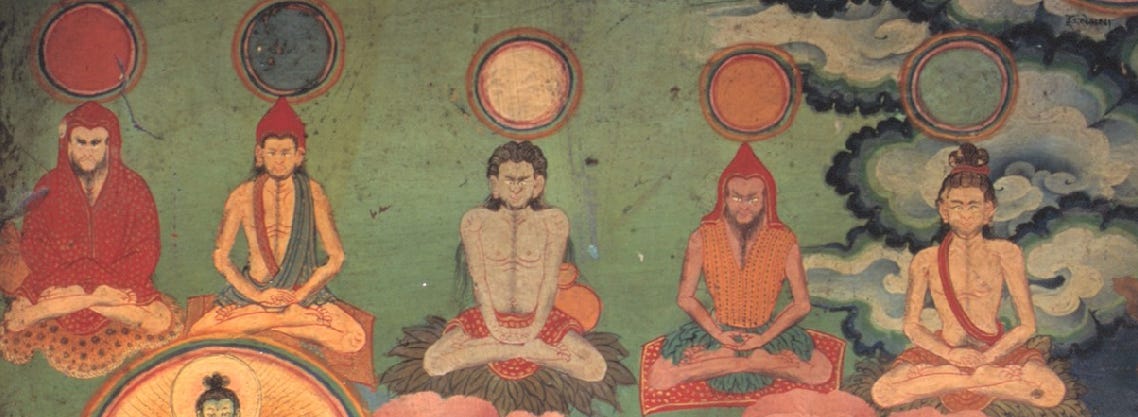Translator’s note
The sixfold or sevenfold posture of Vairocana is the basic form of posture used by both yogic and non-yogic meditation practitioners in Tibet. This posture is also known as the six-point posture of Vairocana, and this sitting posture is effective on six vital points of the body. For example, for yogis, the vajra cross-legged posture helps to control the lower ends of the three channels and apana vayu, a straight spine helps to bring air into the central channel, the mudra of the equipoise hand position below the navel helps to open the central channel, bending the neck helps to control the upper air (prana vayu), touching the tongue to the palate helps to suck nectar, and the eyes resting on the tip of the nose helps with concentration.
This text is taken from the Sakya Lamdre text and was written by Jamayang Loter Wangpo (1847-1914). Regarding the translation, the words in brackets are mine.
ན་མོ་གུརུ་བྷྱ༔ Namo Guru bhyah
Homage to the Guru
ལུས་གནད་ལ་དབབ་པ་རྣམ་པར་སྣང་མཛད་ཀྱི་ཆོས་དྲུག་མན་ངག་དུ་གསུངས་པ་ནི། རང་གཞན་གྱི་བརྗེད་ཐོར་བྲི་བར་བྱ་སྟེ།
Instruction of the six-fold posture of Vairocana, which strikes the vital points of the body, is written down as notes for my own and others' remembrance.
I. Vajrāsana (vajra cross-legged posture).
དེ་སྐད་དུ། རྡོ་རྗེ་སྐྱིལ་ཀྲུང་རྫོགས་སངས་རྒྱས། ཞེས་བྱ་བའི་དོན་ཏེ། དེའང་རྐང་པ་གཡས་ཕྱི་ནས་འཁྱུད་དེ། རྟིང་པ་གཉིས་ཀྱི་བར་དུ་སོར་བཞི་ཙམ་ཡོད་པར་བྱས་ན། ལུས་ཟུངས་ཀྱི་སྣེ་རྩ་གནོན་པའི་གནད་དོ༎
As it says (in the Manjushri Nama Sangirti text), 'Complete Buddhahood (is attained) in Vajrāsana'. It means that (when sitting in Vajrāsana with the feet on opposite legs - between the calf and the thigh) by wrapping the right leg around the left leg, leaving a space of about four inches between the heels, the (lower) end of the channels of the life energy/constituents of the body are subdued.
Other names and meanings of the Vajrasana Sitting Posture
མིང་དོན་ནི། ཕྱི་བདུད་རབ་ཏུ་གཞོམ་པའི་འདུག་སྟངས། ནང་བར་ཆད་མེད་པའི་འདུག་སྟངས། གསང་བ་འཁོར་བའི་རྩ་གཉིས་དབུ་མར་འཇུག་པའི་འདུག་སྟངས། དེ་ཁོ་ན་ཉིད་རྟེན་འབྲེལ་ཟུང་འཇུག་གཉིས་མེད་ཀྱི་འདུག་སྟངས། མཐར་ཐུག་འཚང་རྒྱ་བའི་འདུག་སྟངས༎
Other names and meanings of the Vajrāsana Seated Posture 1. Outer- crushing evil (mara) seated posture. 2. Inner - unhindered sitting posture. 3. Secret - the sitting posture that directs the samsaric right and left channels into the central channel. 4. Non-dual union of suchness (emptiness) and interdependent arising seated posture. 5. Ultimate- sitting posture for attaining enlightenment (this is the meaning of the above quotation from the Manjushri Nama Sangirti text).
II. Hands position: Mudra of equipoise
ལག་པ་མཉམ་གཞག་གི་ཕྱག་རྒྱ་ལྟེ་བའི་འོག་སོར་བཞིས་དམའ་བར་བཅའ་སྟེ། འདིར་རྣལ་འབྱོར་གྱི་རྒྱུད་དང་མཐུན་པར་ལག་པ་གཡས་པ་སྟེང། གཡོན་པ་འོག་ཏུ་གཞག། མཐེབ་སྙིང་གཉིས་ལེགས་པར་སྤྲད་ལ། ལྟེ་ལྐོག་གི་ནང་དུ་བཅར་བས། རྩ་དབུ་མ་ཨུཏྤལ་གཞོན་ནུ་ཁ་འབྱེད་པའི་གནད། རྒོད་མ་ཁ་ཧཱུཾ་སྒྲ་སྒྲོག་པའི་གནད། ཚངས་པའི་མེ་འབར་བའི་གནད་དོ༎
The hands in the mudra of equipoise are held four inches below the navel. Here the formation of the mudra of equipoise is taught according to Yoga Tantra, that is, the right hand is placed over the left hand (palms facing up), the tips of the thumbs together pressing inside the navel. The significance of this hand posture is (i) to open the lower end of the central channel like the opening of the bud of the fresh utpala flower, (ii) to make a roaring sound of hum from the (tummo) mare-faced volcanic mountain in the ocean (vaḍavāmukhaḥ at the navel), (iii) to ignite the fire of Brahma (below the navel).
Other names and meaning of this hand posture
མིང་དོན་ནོ། རིག་པ་རྩེ་གཅིག་ཏུ་སྡུད་པའི་གནད། ཁམས་གསུམ་དབང་དུ་བྱེད་པའི་གནད། གཞན་སྣང་ཟིལ་གྱིས་གནོན་པའི་གནད་དོ། མདོ་ལས་དཔའ་བར་འགྲོ་བའི་ཕྱག་རྒྱའོ༎
The purpose of this hand position is to help focus the mind on a single object, to conquer the three worlds (three channels), and to help overcome the other induced appearances. The Sutra calls this hand position the 'heroic march'.
III. Straight spine
སྒལ་ཚིགས་དངུལ་གྱི་འཁོར་ལོ་བརྩེགས་པ་བཞིན་དུ་བསྲང་སྟེ། དེའི་དགོས་པའམ། མིང་དོན་ནི། ལུས་དྲང་བས་རྩ་དྲང། རྩ་དྲང་བས་ཁམས་དྲང། ཁམས་དྲང་བས་རླུང་དྲང་བ་སྟེ། དྲང་པོ་བཞིའི་གདམས་ངག་གིས་རླུང་རང་གནས་སུ་ཆུད་པའི་གནད། རླུང་རོ་སྐྱོན་ཅན་སེལ་བའི་གནད། མིག་གསལ་བར་བྱེད་པའི་གནད། འཁྲུགས་པ་དང་ཐང་ཆད་པ་ངལ་སོས་པའི་གནད་དོ༎
The spine should be straight like a stacked silver coin (rūpya-cakrī). The purpose and meaning of this posture is that when the (upper) body is straight, the (three) channels become straight (Ṛju), when the channels are straight (not crooked), the (bodily) elements (dhātu) flow straight, and when the bodily elements flow straight, the vital air flows straight. The purpose of this four-instruction to keep (the body, the channels, the elements and the vital air) straight is to help direct the vital air to its place (the central channel), to clear away the harmful residual air (in the channels), to make the eyesight clear, and to free (the body and mind) from the toils of tiredness and restlessness.
IV. Neck bent
མགྲིན་པ་བྱ་ངང་པ་བཞིན་དགུག་པའི་དགོས་པའམ།མིང་དོན་ནི།རླུང་གི་སྒོ་འཕྲང་གཅད་པའི་གནད།ཀོས་ཀོས་ཨོལ་མདུད་གནོན་པའི་གནད།སྟེང་རླུང་རབ་ཏུ་གནོན་པའི་གནད།ཏིང་ངེ་འཛིན་མི་རྟོག་པ་སྐྱེ་བའི་གནད་དོ༎
The purpose and meaning of bending the neck like a swan is that it is crucial for cutting off the narrow doorway of the air, for the chin (cibuka) to press down on the thyroid cartilage (kaṇṭhamaṇi), for the upper air to be pressed down completely, and for non-conceptual samadhi (nirvikalpa samadhi) to arise.
V. Tongue to the palate
ལྕེ་རྐན་ལ་སྦྱར་བའི་དགོས་པའམ། མིང་དོན་ནི། ཡར་རྐན་ལ་བ་འཇོ་བའི་གནད། རྣལ་འབྱོར་པ་ཁམས་བསོ་བའི་གནད། ཚེ་དང་ལུས་ཀྱི་བཅུད་ལེན་སྒྲུབ་པའི་གནད། ལྕེ་རླུང་ནོན་པས་ལྕེ་རྩེ་བདེ་བའི་གནད་དོ༎
The purpose and meaning of joining (the tip of) the tongue to the palate is that it is crucial for milking (nectar) from the palate (uvula/lambikā with the tongue), for restoring the yogi's physical health, for attaining the extraction of essences for prolonging life and health, for making the tongue nimble by gaining control over the air of the tongue.
VI. Eyes on the tip of the nose
མིག་སྣ་རྩེར་དབབ་པའི་དགོས་པའམ། མིང་དོན་ནི། དམིགས་པའི་བྱིང་རྒོད་སྤོང་བའི་གནད། རིག་པ་གསལ་བར་སྐྱེད་པའི་གནད། ནང་གི་འབྱུང་བ་སྙོམས་པའི་གནད། ཚུལ་བཞིན་ཡིད་ལ་བྱེད་པའི་ལྟ་སྟངས་ཏེ། དེ་སྐད་དུའང། གཉའ་ཤིང་གང་ཙམ་བལྟ་ཞིང་འགྲོ་ལ་སེམས་འཁྲུལ་མེད། ཅེས་པའི་དོན་ཏོ༎
The purpose and meaning of lowering the eyes (gaze) to the tip of the nose is that it is crucial for getting rid of mental sinking and agitation of the mental focus, for making the mind clearer, and for keeping the inner (four) elements in balance. This eye position is called 'correct thinking gaze'. As it is said (in The Prajnaparamita-Sancayagatha), 'Whether one is walking, sleeping or sitting, if one maintains full vigilance and keeps one's gaze about the length of a yoke, mistaken mind towards other beings won't arise.
Tsering Dorji's Newsletter is a reader-supported publication. If you enjoy my posts and translations. Click the button below.






